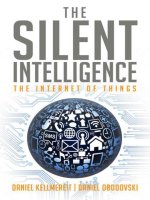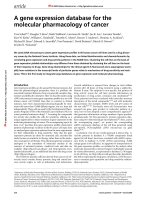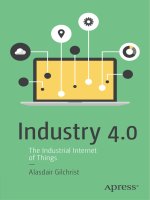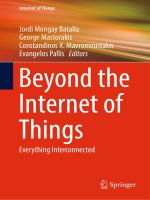Scaling data science for the industrial internet of things
Bạn đang xem bản rút gọn của tài liệu. Xem và tải ngay bản đầy đủ của tài liệu tại đây (2.31 MB, 25 trang )
Hardware
Scaling Data Science for the
Industrial Internet of Things
Advanced Analytics in Real Time
Andy Oram
Scaling Data Science for the Industrial Internet of Things
by Andy Oram
Copyright © 2017 O’Reilly Media. All rights reserved.
Printed in the United States of America.
Published by O’Reilly Media, Inc., 1005 Gravenstein Highway North,
Sebastopol, CA 95472.
O’Reilly books may be purchased for educational, business, or sales
promotional use. Online editions are also available for most titles
( For more information, contact our
corporate/institutional sales department: 800-998-9938 or
Editor: Brian Jepson
Production Editor: Kristen Brown
Proofreader: Kristen Brown
Interior Designer: David Futato
Cover Designer: Randy Comer
Illustrator: Rebecca Demarest
December 2016: First Edition
Revision History for the First Edition
2016-12-16: First Release
2017-01-25: Second Release
The O’Reilly logo is a registered trademark of O’Reilly Media, Inc. Scaling
Data Science for the Industrial Internet of Things, the cover image, and
related trade dress are trademarks of O’Reilly Media, Inc.
While the publisher and the author have used good faith efforts to ensure that
the information and instructions contained in this work are accurate, the
publisher and the author disclaim all responsibility for errors or omissions,
including without limitation responsibility for damages resulting from the use
of or reliance on this work. Use of the information and instructions contained
in this work is at your own risk. If any code samples or other technology this
work contains or describes is subject to open source licenses or the
intellectual property rights of others, it is your responsibility to ensure that
your use thereof complies with such licenses and/or rights.
978-1-491-97912-9
[LSI]
Scaling Data Science for the
Industrial Internet of Things
Few aspects of computing are as much in demand as data science. It underlies
cybersecurity and spam prevention, determines how we are treated as
consumers by everyone from news sites to financial institutions, and is now
part of everyday reality through the Internet of Things (IoT). The IoT places
higher demands on data science because of the new heights to which it takes
the familiar “V’s” of big data (volume, velocity, and variety). A single device
may stream multiple messages per second, and this data must either be
processed locally by sophisticated processors at the site of the device or be
transmitted over a network to a hub, where the data joins similar data that
originates at dozens, hundreds, or many thousands of other devices.
Conventional techniques for extracting and testing algorithms must get
smarter to keep pace with the phenomena they’re tracking.
A report by ABI Research on ThingWorx Analytics predicts that “by 2020,
businesses will spend nearly 26% of the entire IoT solution cost on
technologies and services that store, integrate, visualize and analyze IoT data,
nearly twice of what is spent today” (p. 2). Currently, a lot of potentially
useful data is lost. Newer devices can capture this “dark data” and expose it
to analytics.
This report discusses some of the techniques used at ThingWorx and two of
its partners — Glassbeam and National Instruments — to automate and speed
up analytics on IoT projects. These activities are designed for high-volume
IoT environments that often have real-time requirements, and may cut the
time to decision-making by orders of magnitude.
Tasks in IoT Monitoring and Prediction
To understand the demands of IoT analytics, consider some examples:
Farming
A farm may cover a dozen fields, each with several hundred rows of
various crops. In each row, sensors are scattered every few feet to report
back several measures, including moisture, temperature, and chemical
composition of the soil. This data, generated once per hour, must be
evaluated by the farmer’s staff to find what combination works best for
each crop in each location, and to control the conditions in the field.
Random events in the field can produce incorrect readings that must be
recognized and discarded. Data may be combined with observations
made by farmers or from the air by drones, airplanes, or satellites.
Factory automation
Each building in a factory campus contains several assembly lines, each
employing dozens of machines manipulated by both people and robots.
A machine may have 20 sensors reporting its health several times a
second in terms of temperature, stress, vibration, and other
measurements. The maintenance staff want to determine what
combination of measurements over time can indicate upcoming failures
and need for maintenance. The machines come from different vendors
and are set up differently on each assembly line.
Vehicle maintenance
A motorcycle manufacturer includes several sensors on each vehicle
sold. With permission from customers, it collects data on a daily basis
from these sensors. The conditions under which the motorcycles are
operated vary widely, from frigid Alaska winters to sweltering Costa
Rican summers. The manufacturer crunches the data to determine when
maintenance will be needed and to suggest improvements to designers
so that the next generation of vehicles will perform better.
Health care
A hospital contains thousands of medical devices to deliver drugs,
monitor patients, and carry out other health care tasks. These devices are
constantly moved from floor to floor and attached to different patients
with different medical needs. Changes in patient conditions or in the
functioning of the devices must be evaluated quickly and generate alerts
when they indicate danger (but should avoid generating unnecessary
alarms that distract nursing staff). Data from the devices is compared
with data in patient records to determine what is appropriate for that
patient.
In each of these cases, sites benefit by combining data from many sources,
which requires network bandwidth, storage, and processing power. The
meaning of the data varies widely with the location and use of the plants,
vehicles, or devices being monitored. A host of different measurements are
being collected, some of which will be found to be relevant to the goals of the
site and some of which have no effect.
The Magnitude of Sensor Output
ThingWorx estimates that devices and their output will triple between 2016
and 2020, reaching 50 billion devices that collectively create 40 zetabytes of
data. A Gartner report (published by Datawatch, and available for download
by filling out a form), says:
A single turbine compressor blade can generate 500GB of data per day.
A typical wind farm may generate 150,000 data points per second.
A smart meter project can generate 500 million readings of data per day.
Weather analysis can involve petabytes (quintillions of bytes) of data.
What You Can Find in the Data
The concerns of analysts and end users tend to fall into two categories, but
ultimately are guided by the goal to keep a system or process working
properly. First, they want to catch anomalies: inputs that lie outside normal
bounds. Second, in order to avoid the crises implied by anomalies, they look
for trends: movements of specific variables (also known as features or
dimensions) or combinations of variables over time that can be used to
predict important outcomes. Trends are also important for all types of
planning: what new products to bring to market, how to react to changes in
the environment, how to redesign equipment so as to eliminate points of
failure, what new staff to hire, and so on.
Feature engineering is another element of analytics: new features can be
added by combining features from the field, while other features can be
removed. Features are also weighted for importance.
One of the first judgments that an IoT developer has to make is where to
process data. A central server in the cloud has the luxury of maintaining
enormous databases of historical data, plus a potentially unlimited amount of
computing power. But sometimes you want a local computer on-site to do the
processing, at least as a fallback solution to the cloud, for three reasons. First,
if something urgent is happening (such as a rapidly overheating motor), it
may be important to take action within seconds, so the data should be
processed locally. Second, transmitting all the data to a central server may
overload the network and cause data to be dropped. Third, a network can go
down, so if people or equipment are at risk, you must do the processing right
on the scene.
Therefore, a kind of triage takes place on sensor data. Part of it will be
considered unnecessary. It can be filtered out or aggregated: for instance, the
local device may communicate only anomalies that suggest failure, or just the
average flow rate instead of all the minor variations in flow. Another part of
the data will be processed locally. Perhaps it will also be sent into the cloud,
along with other data that the analyst wants to process for predictive
analytics.
Local processing can be fairly sophisticated. A set of rules developed through
historical analysis can be downloaded to a local computer to determine the
decisions it makes. However, this is static analysis. A central server
collecting data from multiple devices is required for dynamic analysis, which
encompasses the most promising techniques in modern data science.
Naturally, the goal of all this investment and effort is to take action: fix the
broken pump, redesign a weak joint in a lever, and so on. Some of this can be
automated, such as when a sensor indicates a problem that requires a piece of
machinery to shut down. A shut-down can also trigger the start of an
alternative piece of equipment. Some operations are engineered to be selfadjusting, and predictive analytics can foster that independence.
Characteristics of Predictive Analytics
In rising to the challenge of analyzing IoT’s real-time streaming data, the
companies mentioned in this report have had to take into account the
challenges inherent in modern analytics.
A Data Explosion
As mentioned before, sensors can quickly generate gigabits of data. These
may be reported and stored as thousands of isolated features that intersect and
potentially affect each other. Furthermore, the famous V’s of big data apply
to the Internet of Things: not only is the volume large, but the velocity is high,
and there’s a great deal of variety. Some of the data is structured, whereas
some may be in the form of log files containing text that explains what has
been tracked. There will be data you want to act on right away and data you
want to store for post mortem analysis or predictions.
You Don’t Know in Advance What Factors are Relevant
In traditional business intelligence (BI), a user and programmer would meet
to decide what the user wants to know. Questions would be quite specific,
along the lines of, “Show me how many new customers we have in each
state” or “Show me the increases and declines in the sales of each product.”
But in modern analytics, you may be looking for unexpected clusters of
behavior, or previously unknown correlations between two of the many
variables you’re tracking — that’s why this kind of analytics is popularly
known as data mining. You may be surprised which input can help you
predict that failing pump.
Change is the Only Constant
The promise of modern analytics is to guide you in making fast turns.
Businesses that adapt quickly will survive. This means rapidly recognizing
when a new piece of equipment has an unanticipated mode of failure, or
when a robust piece of equipment suddenly shows problems because it has
been deployed to a new environment (different temperature, humidity, etc.).
Furthermore, even though predictive models take a long time to develop, you
can’t put them out in the field and rest on your laurels. New data can refine
the models, and sometimes require you to throw out the model and start over.
Tools for IoT Analytics
The following sections show the solutions provided by some companies at
various levels of data analytics. These levels include:
Checking thresholds (e.g., is the temperature too high?) and issuing
alerts or taking action right on the scene
Structuring and filtering data for input into analytics
Choosing the analytics to run on large, possibly streaming data sets
Building predictive models that can drive actions such as maintenance
Local Analytics at National Instruments
National Instruments (NI), a test and measurement company with a 40-year
history, enables analytics on its devices with a development platform for
sensor measurement, feature extraction, and communication. It recognizes
that some calculations should be done on location instead of in the cloud.
This is important to decrease the risk of missing transient phenomena and to
reduce the requirement of pumping large data sets over what can get to be
quite expensive IT and telecom infrastructure.
Measurement hardware from NI is programmed using LabVIEW, the NI
software development environment. According to Ian Fountain, Director of
Marketing, and Brett Burger, Principal Marketing Manager, LabVIEW
allows scientists and engineers without computer programming experience to
configure the feature extraction and analytics. The process typically starts
with sensor measurements based on the type of asset: for example, a
temperature or vibration sensor. Nowadays, each type of sensor adheres to a
well-documented standard. Occasionally, two standards may be available.
But it’s easy for an engineer to determine what type of device is being
connected and tell LabVIEW. If an asset requires more than one
measurement (e.g., temperature as well as vibration), each measurement is
connected to the measurement hardware on its own channel to be separately
configured.
LabVIEW is a graphical development environment and provides a wide
range of analytical options through function blocks that the user can drag and
drop into the program. In this way, the user can program the device to say,
“Alert me if vibration exceeds a particular threshold.” Or in response to a
trend, it can say, “Alert me if the past 30,000 vibration readings reveal a
condition associated with decreasing efficiency or upcoming failure.”
NI can also transmit sensor data into the cloud for use with an analytical tool
such as ThingWorx Analytics. Because sensors are often high bandwidth,
producing more data than the network can handle, NI can also do feature
extraction in real time. For instance, if a sensor moves through cycles of
values, NI can transfer the frequency instead of sending over all the raw data.
Together with ThingWorx, NI is exploring anomaly detection as a future
option. This would apply historical data or analytics to the feature.
Extracting Value from Machine Log Data With
Glassbeam
Glassbeam brings a critical component of data from the field — log files —
into a form where it can be combined with other data for advanced analytics.
According to the Gartner report cited earlier, log files are among the most
frequently analyzed data (exceeded only by transaction data), and are
analyzed about twice as often as sensor data or machine data.
Glassbeam leverages unique technology in the data translation and
transformation of any log file format to drive a differentiated “analytics-as-aservice” offering. It automates the cumbersome multi-step process required to
convert raw machine log data into a format useful for analytics. Chris Kuntz,
VP of Marketing at Glassbeam, told me that business analysts and data
scientists can spend 70-80 percent of their time working over those logs, and
that Glassbeam takes only one-twentieth to one-thirtieth of the time.
Glassbeam’s offering includes a visual data modeling tool that performs
parsing and extract, transform, load (ETL) operations on complex machine
data, and a highly scalable big data engine that allows companies to organize
and take action on transformed machine log data. Binary and text streams can
also be handled. As its vertical industry focus, Glassbeam’s major markets
include storage networking, wireless infrastructure, medical devices, and
clean energy.
Log files are extremely rich in content and carry lot of deep diagnostics
information about machine health and usage. However, sifting through varied
log formats and parsing to uncover the hidden nuggets in this data is a
headache every administrator dreads. Does this field start at the same
character position in every file? Does it occupy a fixed number of positions
or end with a marker? Are there optional fields that pop up in certain types of
records?
Figuring all this out is the kind of task that’s ripe for automation. Instead of
coding cumbersome logic in traditional approaches like regular expressions,
Glassbeam’s Semiotic Parsing Language (SPL) can define and run analytics
that compare fields in different records and perform other analytics to figure
out the structure of a file.
Note that the analytics can also be distributed: some parts can run right at the
edge near the device, feeding results back to a central server, and other parts
can run on the cloud server with access to a database of historical
information.
Glassbeam can also perform filtering — which can greatly reduce the amount
of data that has to be passed over the network — and some simple analytics
through technologies such as correlations, finite state machines, and Apache
Spark’s MLlib. For instance, the resulting analytics may be able to tell the
administrator whether a particular machine was used only 50% of the time,
which suggests that it’s underutilized and wasting the client’s money.
ThingWorx and Glassbeam exchange data in several ways, described in this
white paper. ThingWorx can send messages one way to an ActiveMQ broker
run by Glassbeam. ThingWorx can also upload data securely through
FTP/SSH. Glassbeam also works directly with ThingWorx Analytics by
plugging directly into the ThingWorx Thing Model, making it easier and
faster to build advanced analytics, predictions, and recommendations within
ThingWorx mashups and ThingWorx-powered solutions.
In addition to providing a powerful data parsing and transformation engine,
Glassbeam has a suite of tools that allow users to search, explore, apply rules
and alerts, and generate visualizations on data from machine logs, as well as
take action on analytics results from ThingWorx. These powerful user and
administrative tools complement and feed into the analytics offered by
ThingWorx Analytics.
Analytics in ThingWorx
As resources grow, combining larger data sets and more computer processing
power, you can get more insights from analytics. Unlike the three companies
profiled earlier in this report, ThingWorx deals with the operations on
devices directly. It’s a cloud-based solution that accepts data from sensors —
it currently recognizes 1,400 types — or from intermediate processors such
as the companies seen earlier. Given all this data, ThingWorx Analytics (a
technology that PTC brought in by purchasing the company Coldlight) then
runs a vast toolset of algorithms and techniques to create more than just
predictive models: causal analysis, relationship discovery, deep pattern
recognition, and simulation.
According to Joseph Pizonka, VP of Product Strategy for ThingWorx
Analytics, all the user needs to do is tell the system what the objective is —
for instance, that a zero flow rate indicates a failure — and what data is
available to the system. The analytics do the rest.
For instance, analytics can generate a slgnal, the characteristics of a device
that show that it is high-performing or low-performing. Various features you
want to track — the model and age of the machine, for instance — form a
profile. Pizonka describes profile generation as “finding a needle in a
haystack.”
Internally, ThingWorx Analytics performs the standard machine learning
process of injecting training data into model building and validating the
results with test data, and later in production with data from the field. Model
building is extremely broad, using a plethora of modern techniques like
neural networks to search for the most accurate prediction model.
ThingWorx Analytics also runs continuously and learns from new input. It
compares its prediction models to incoming data and adjusts the models as
indicated. Pizonka says that the automated system can generate in minutes to
hours what a human team would take months to accomplish. It’s good for
everyday problems, letting data scientists focus on more meaty tasks.
Prerequisites for Analysis
Some common themes appear in the stories told by the various companies in
this article.
You need to plan your input. If you measure the wrong things, you will
not find the trends you want.
You may need to train your model, even if it evolves automatically upon
accepting data.
You need a complete view of your machine data, and you need that data
in the right format. If it’s not in the right format, you’ll need to parse it
into a structure suitable for analysis.
The value of analytics increases dramatically as data sizes increase —
but they may need to increase logarithmically.
The variety of analytical techniques available to modern data crunchers is
unprecedented and overwhelming. The examples in this report show that it is
possible to marshal them and put them to use in your IoT environment to find
important patterns, make predictions, and guide humans and machines toward
better outcomes.
About the Author
Andy Oram is an editor at O’Reilly Media. An employee of the company
since 1992, Andy currently specializes in programming topics. His work for
O’Reilly includes the first books ever published commercially in the United
States on Linux, and the 2001 title Peer-to-Peer.
Scaling Data Science for the Industrial Internet of Things
Tasks in IoT Monitoring and Prediction
The Magnitude of Sensor Output
What You Can Find in the Data
Characteristics of Predictive Analytics
A Data Explosion
You Don’t Know in Advance What Factors are Relevant
Change is the Only Constant
Tools for IoT Analytics
Local Analytics at National Instruments
Extracting Value from Machine Log Data With Glassbeam
Analytics in ThingWorx
Prerequisites for Analysis









